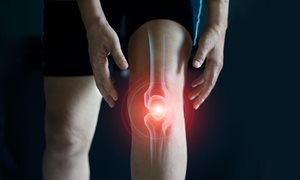
The Anatomy Projector, developed at the Radboudumc, allows surgeons to operate much more accurately with projected augmented reality.
If you project relevant information such as blood vessels onto a patient's skin during surgery, you can operate much more accurately. The Radboudumc in Nijmegen developed the Anatomy Projector based on augmented reality. The translation of medical information from a screen to the patient is difficult when a plastic surgeon has to work on a microscopic scale. There must be another way, thought Dr. Stefan Hummelink. As a student of Technical Medicine he did his graduation research at the Radboudumc in the department of Plastic Surgery. That was in 2012, when augmented reality was still in its infancy. Hummelink built the prototype of the Anatomy Projector in his shed.
Breast Reconstruction
"The principle of projected augmented reality was innovative at the time and we were able to patent it," says Hummelink. Since then the device has been further developed into a device as large as a thick tablet. It is used weekly during breast operations at the Radboudumc. "In breast reconstruction, a so-called free patch is extracted. Skin and fat, fed by a blood vessel, is reattached under the microscope at the breast. It is important to spare the supplying blood vessels, otherwise the operation will fail."
3D plan on the skin
"With the projector we can show exactly on the skin where these blood vessels, but also for example lymph nodes of a patient are located," explains Hummelink. This is different for each patient. This information is extracted from a CT scan, on the basis of which a 3D plan is made. The patient is given markers on the skin and during surgery the 3D plan is projected onto the body. "This gives additional information to the plastic surgeon and the team around it," says Dr. Hummelink.
Without glasses
Even if the projector moves, the images remain correctly displayed on the patient. This allows the plastic surgeon to work more effectively and efficiently. Another advantage is that the surgeon does not need AR glasses and everyone in the operating room can watch the projection with them. In 2017, Hummelink received funding within NWO's Demonstrator program to further develop the projector.
Venture challenge
The Anatomy Projector was recently selected for NWO's Venture Challenge. This challenge helps starting entrepreneurs to bring their product or service to the market. In a number of weeks a business case is set up. And the product is presented to potential investors. Hummelink hopes that a company will come forward to further develop the product and eventually bring it to the market. Personally, he would like to continue to come up with solutions for healthcare from a teaching hospital. "After all, this is where you see exactly what doctors are up against and where you can further improve care."
More potential
The Anatomy Projector is currently only used for breast reconstructions. But according to Hummelink, the technology has much more potential. "Besides blood vessels, muscles, tendons or nerves, you can also project other information onto the body." However, this also requires more research and costs a lot of money. "I also hope that the Venture Challenge we are about to launch will be a success, and that investors or companies who are interested will come forward. After all, projections in the operating room are the future!"
Source Innovation Origins
-
Want to know more about these subjects? Click on the buttons below for more news.
Related news items

Meniscus prosthesis Atro Medical receives 2.5 million EU grant
10 June 2022 The European Commission is providing a 2.5 million euro grant to ATRO Medical, spin-off of The Radboudumc and DSM, for the accelerated development of their artificial meniscus. go to page
Field research on malaria vaccine offers unexpected surprise
23 May 2022Field research on the effectiveness of a malaria vaccine, came up with unexpected results for an international group of researchers including Benjamin Mordmüller of Radboudumc. The vaccine evokes a broader response against malaria proteins than there are in the vaccine.
go to page
Tailored drug dosage for pregnant women
14 March 2022 Three quarters of women in the Netherlands use some form of medication during pregnancy, but little is known about the appropriate dosages. Research by the Radboudumc, MUMC+ and Lareb Mothers of Tomorrow should change this. go to page
NIH grant for follow-up research on tuberculous meningitis
10 February 2022Met subsidie van het Amerikaanse NIH gaat With a grant from the U.S. NIH, Reinout van Crevel will continue to unravel the disease process of tuberculous meningitis.
go to page
Micro-Cosmos helps patient unwind during hospitalization
10 February 2022 Nijmegen-based Micro-Cosmos is a start-up that makes retractable hoods to speed up the recovery of hospitalized patients. go to page
